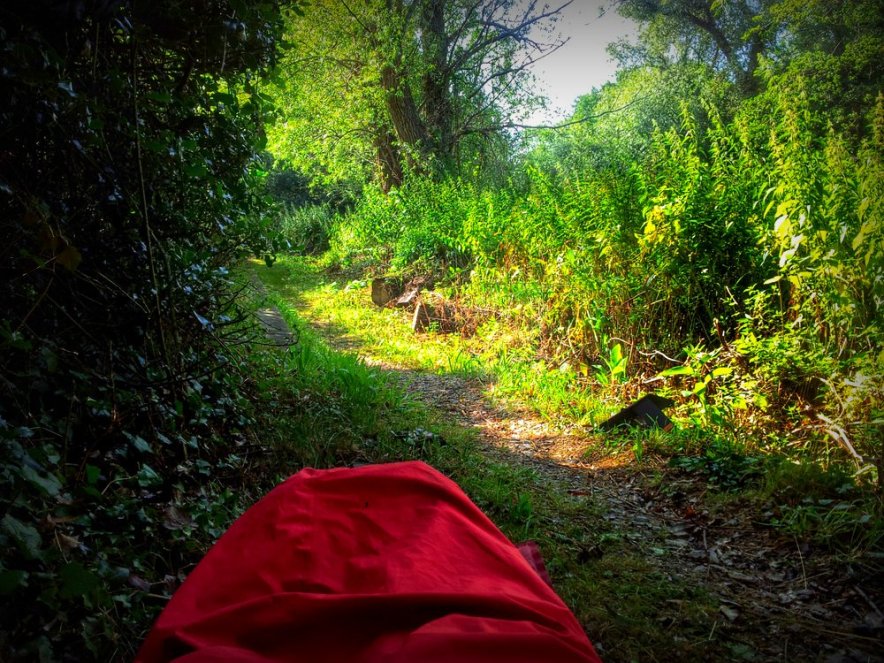Whew.
Well, it’s been a rough week. I stepped away from my writing work to deal with family issues, and the stress of it has left me exhausted. Now everything’s resolved, it’s time to open my laptop and pick up all my work where I left off.
But first – my morning walk.
My boots are cold as I shove my feet into them. I know the drill: five minutes of shivering before I reach optimal walking temperature, and an ice-cold sea breeze that makes my eyes stream until I can put the wind at my back…
I open the door – and sunlight streams in.
And bird song.
And stillness.
Not a breath of wind.
I lift my face to the sun, and the previous week starts to recede into unpleasant memory.
Ah. This is more like it.

Sunlight is magic.
More specifically, it’s alchemy – a transfer of something seemingly worthless into the most precious of substances, such as the glucose that allows plants to grow, or the solar electricity that’s going to power pretty much everything in the near future (including train travel).
The only difference is that real alchemy was a mixture of protoscientific speculations and pseudoscientific twaddle that rarely led to anything that worked – and sunlight never stops working.
Take the magic that happens under your skin when you go for a walk.
Just under the surface, you have a layer of something called 7-dehydrocholesterol, a specific type of steroid alcohol that breaks down under ultraviolet light into cholecalciferol and gets whisked away into your liver to be rendered down into the chemical 25-hydroxyvitamin D, which then gets shunted into the kidneys and turned into 1.25-dihydroxyvitamin D…
And suddenly, your body has a renewable supply of an incredibly useful hormone that we’re only just starting to understand the effects of – which is manufactured entirely on autopilot.
This miracle of chemical engineering starts with the ultraviolet light found in sunlight.
It doesn’t take much. Thirty minutes of strong sunshine three days a week is usually enough to keep you healthy.
But exactly how healthy is that?
Do you know anyone who never seems to get head-colds or catch the ‘flu? Do you find this intensely annoying? Well, cheer up: medical science may have uncovered their unfair advantage.
A few days ago, the BBC reported on a study that suggested Vitamin D “could stop colds or flu” (sparking all sorts of local news stories). It seems that sunlight on your skin can boost your immune system in a measurable way. The medical profession has long known how Vitamin D helps build strong bones – but this is something else, with potentially huge consequences for the vitamin supplement industry, the stretched, under-funded NHS, and our ability to keep ourselves healthy without the help of doctors.
This news isn’t conclusive. It’s the start of a long process of nailing down the facts.
But if being deprived of sunlight sends a percentage of us into deep depression, triggering anxiety, overeating and an inability to concentrate in much of the rest of us, it makes sense that evolution will have found other ways to gently nudge us out into the sunshine.

So, if it’s very early morning, and the sun is ahead of me – that means I’m pointing east, right?
Thought experiment: let’s say it’s dawn, and I dump my backpack here and start walking towards where the sun is creeping over the horizon, and I keep walking until it’s directly overhead – and then I turn right round and follow the sun the other way, until it meets the western horizon at dusk. Would I be able to find my backpack again?
We all know the sun always rises in the east and sets in the west. It’s so credible a fact that it’s used as a yardstick to measure the solidity of other statements. “As sure as the sun rises in the east….”
Except for over 350 days of the year, it’s flat-out wrong.

If I was out in the wilds and I was trying this for real, let’s hope I was doing so around March 21st (a month from now) or September 22nd, because they’re the only time this would actually work.
It depends on your level of accuracy. If you define “west” or “east” as “you know, that part of the sky over there” and wave your hand in a vaguely drunken manner that covers about 90 degrees of arc, well, yes, you can have it.
But if you’re out walking, and you’re trying to navigate with it? Ruh roh.
Outside of the Spring and Fall equinoxes, the tilt of the Earth pushes the rising and setting sun to the north or the south, depending on where you are in the world. In the UK right now, the morning sun is moved southwards due to the tilt of the earth. The sun rises in the southeast and sets in the southwest, covering a smaller arc of the sky than in high summer, and giving us shorter days.
(Fun fact: I spent an embarrassing amount of my adult life thinking summers happen because the Earth gets nearer the sun at that time of year. Um. Yeah. Oops.)
So – it appears Spring has sprung.
What shall we do with it, you and I?
PREVIOUSLY: A Mile A Day #13: Giving Up And Taking It Personally
NEXT: A Mile A Day #15: The Ultimate Guide To Walking Gear For Complete Beginners
